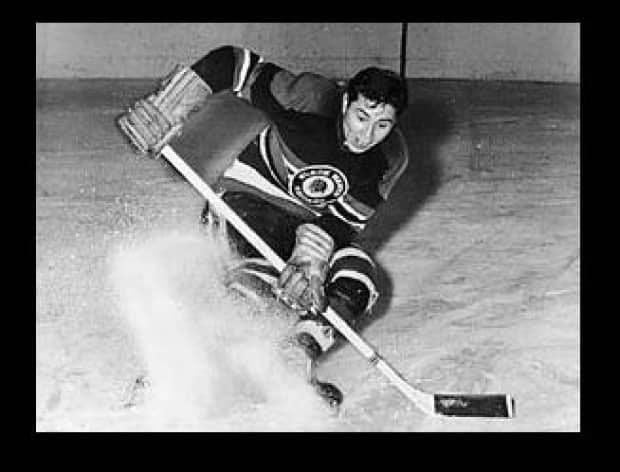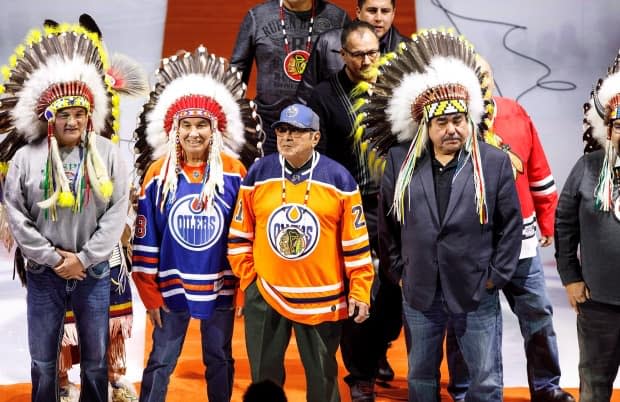Late Fred Sasakamoose's TRC testimony left lasting impression, remembers commissioner
The late Fred Sasakamoose, one of the first Indigenous people to play hockey in the NHL, had a tremendous impact on his community.
As a residential school survivor, he also had a tremendous impact on the work of Canada's Truth and Reconciliation Commission (TRC), especially for one of its commissioners.
Sasakamoose died earlier this week at the age of 86, due to complications from COVID-19.
Two years after the TRC started traveling across Canada to hear testimony from residential school survivors, it visited Prince Albert, Saskatchewan, for three days.
On that third day, Sasakamoose gave his testimony.
It was a pivotal moment for commissioner Marie Wilson.
"There was a point in the commission where I thought to myself, what if we do all this work and we bear witness to people spilling literally blood, sweat, and tears, and nothing changes and nothing happens?" she said.

However, after he spoke, Wilson realized that all the work the commission was doing would never be a waste.
"For those who are participating and for those who are taking part and for those who were in the room, things were shifting and things were lightening and things were transforming," she said.
"Fred Sasakamoose epitomized that."
'The red man in the middle, that was me'
Sasakamoose played 11 games with the Chicago Blackhawks during the 1953-54 season. He played for a few more years in junior and senior leagues after that, before returning to his home in Northern Saskatchewan.
There, he became heavily involved in youth sports, and served as a band councillor and then chief of the Ahtahkakoop Cree Nation, where he grew up.
Before he rose to prominence, though, there was residential school.
In 1940, when Sasakamoose wasn't quite seven years old, he and his eight-year-old brother were forcibly taken from their parents and sent to St. Michael's Residential School.
It would be two years before the boys saw their parents again.
Sasakamoose told his story to the commission, beginning "with tears and [an] inability to speak," Wilson said.
"And he pushed through it … he found beautiful things to give the room."
Wilson said she can still picture Sasakamoose, eight years later, talking about how his hockey career began, and using the word "shame."
"[Shame] was a common residential school storyline, unfortunately--and he talked about his shame of being this Indian in the dressing room. That's the language that he used," she said.
Later in his testimony, though, Sasakamoose told commissioners about how the sport had helped him heal.
Later in his hockey career, Wilson said, Sasakamoose played in the middle of a line with a Black right winger and Chinese left winger.
Sasakamoose told the commission he fashioned his skates to reflect that, putting a black lace on his right skate and a yellow one on his left skate.
Wilson said Sasakamoose then told them, "the red man, in the middle, that was me."
She remembers exactly what he said after that:
"What an international flavour," she recalled him saying. "It carried me to realize that the world was not only meant for the white man, that there was a place for me, too."
"We were one. It didn't matter the colour. We were there for one another."
The heart of reconciliation
In that moment, Wilson said, Sasakamoose's sentiments were at the heart of the spirit of reconciliation.
"But it was also about the purpose and the hope and the dreams that survivors have put on trying to find a place in a country that has been so exclusive," she said. "Where they've been left on the fringes of caring, for so many, all of that shame and loss."

Wilson said toward the end of Sasakamoose's testimony, he spoke about giving back, from the survivors table.
She was listening with commissioner Chief Wilton Littlechild, himself a residential school survivor, and friends with Sasakamoose.
He said to Littlechild that he was a survivor, and told Wilson that she was a woman, and women were strong, she recalled.
"It was an encouragement to us. It was an encouragement to the room," Wilson said.
"And it was, I think, just such a snapshot of his generous, generous character to push through his own difficulties and to have a lot to offer to everyone around him.
"That's how I remember him."


